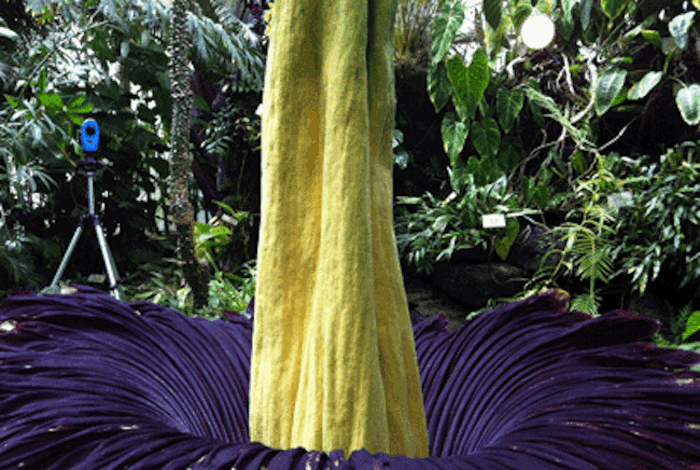Smells Fishy: Putrid 'Corpse Flower' Blooms

The place smells like death, but that didn't keep crowds away from the UC Botanical Garden in Berkeley, California, this weekend.
More than 2,300 visitors queued up on Saturday (July 25) to meet Trudy, an enormous "corpse flower" that was in bloom. Corpse flowers (Amorphophallus titanum, which means "giant, misshapen penis") burst into enormous purple-and-yellow blooms only once every few years. But it's not the sight that attracts attention — it's the smell. These flowers get their name from their scent, which is reminiscent of rotting flesh.
"It's very difficult to describe the smell," Paul Licht, UC Botanical Garden director, said in a statement. "I've been saying for years that it smells like a large, dead mammal — a rat or a dog or a cow. Other people say it smells like dead fish." [In Images: A Corpse Flower Blooms]
The corpse flower, or Titan Arum, is native to Sumatra, Indonesia. The plants are rare, and they're threatened by rainforest destruction, according to the Biological Sciences Greenhouse at The Ohio State University.
Corpse-flower blooms are typically about 8 feet (2.4 meters) tall. Their stink is tailor-made to attract flies and other carrion-eaters that act as pollinators for the plant. Bizarrely, the yellow center of the bloom — called the spadix — actually heats up to help spread the smell. On the first night of blooming, the spadix warms to about 98 degrees Fahrenheit (36.6 degrees Celsius), according to the Biological Sciences Greenhouse.
Berkeley's Trudy is a bit of a pip-squeak, with a bloom only 4.5 feet (1.4 m) tall. Building such a large bloom takes a massive amount of energy, Licht said, which is why corpse plants muster up a flower only every few years. The blooms last mere days.
The rest of the plant's life cycle is fairly subtle. According to the Biological Sciences Greenhouse, the only visible part of a Titan Arum during the first year and a half of its life is a small leaf aboveground. The plant's belowground tuber grows during this time, after which the leaf dies and the plant goes dormant for up to six months. This cycle of growth and dormancy continues multiple times, with the leaf and tuber getting bigger each time. Finally, the plant will put out a bloom, sometimes up to a decade after it first sprouted.
Sign up for the Live Science daily newsletter now
Get the world’s most fascinating discoveries delivered straight to your inbox.
It's very challenging to predict when a corpse flower will bloom, Licht said, adding that he has never been spot-on about when one of the UC Berkeley plants will flower. Part of the reason is that corpse flowers have not been studied much in the wild, he said.
"Sadly, we don't have very much information on these from the habitat of Sumatra," he said. "We don't know how many are left. We don't know how long they live. We don't know how old they have to be before they bloom. We don't know how often they bloom. We don't know what time of year they bloom."
As of Monday (July 27), Trudy (actually a male plant, according to the UC Botanical Garden) was wilting and no longer emitting its signature stink. Researchers at the Garden have been collecting pollen from the plant for study. Visitors can still see the wilting flower during normal operating hours.
Follow Stephanie Pappas on Twitter and Google+. Follow us @livescience, Facebook & Google+. Original article on Live Science.

Stephanie Pappas is a contributing writer for Live Science, covering topics ranging from geoscience to archaeology to the human brain and behavior. She was previously a senior writer for Live Science but is now a freelancer based in Denver, Colorado, and regularly contributes to Scientific American and The Monitor, the monthly magazine of the American Psychological Association. Stephanie received a bachelor's degree in psychology from the University of South Carolina and a graduate certificate in science communication from the University of California, Santa Cruz.











